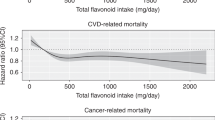Abstract
Objective: To examine the role of six flavonoid classes (flavanones, flavan-3-ols, flavonols, flavones, anthocyanidins and isoflavones) and vitamin C in the aetiology of stomach cancer. Methods: Case–control study undertaken in Greece in the 1980s. Dietary information was obtained from 110 patients with incident stomach adenocarcinoma and 100 control patients. Flavonoid estimates were based on the recently released database of the US Department of Agriculture. Results: In models including sociodemographic variables, energy intake, vegetables, fruits and, alternatively, vitamin C the six flavonoid classes, only flavanones and vegetables remained significantly inversely associated with stomach cancer risk. The odds ratio (95% confidence intervals) per one standard deviation increase of intake of flavanones was 0.55 (0.31–0.96) whereas for vitamin C it was 1.05 (0.46–2.41). When fruits and vegetables were not adjusted for, both vitamin C and several flavonoid categories were inversely associated with stomach cancer risk, but these associations could be attributed to other compounds in these foods. Conclusions: Among the major flavonoid classes studied, only flavanone intake is inversely associated with stomach cancer risk and could account for the apparent protective effect of fruit intake against this form of cancer. Additional factors, however, are likely to be involved in the consistent protection conveyed by vegetables.
Similar content being viewed by others
References
Parkin DM, Whelan SL, Ferlay J, Raymond L, Young J (1997) Cancer Incidence in Five Continents. Vol. VII. Lyon: International Agency for Research on Cancer.
IARC (1994) Schistosomes, liver flukes and Helicobacter pylori. IARC Working Group on the Evaluation of Carcinogenic Risks to Humans. Lyon, 7-14 June 1994. IARC Monogr Eval Carcinog Risks Hum 61: 1-241.
Nyren O, Adami H-O (2002) Stomach cancer. In: Adami H-O, Hunter D, Trichopoulos D, eds. Textbook of Cancer Epidemiology. New York: Oxford University Press, pp. 162-182.
Steinmetz KA, Potter JD (1996) Vegetables, fruit, and cancer prevention: a review. J Am Diet Assoc 96: 1027-1039.
World Cancer Research Fund and American Institute for Cancer Prevention (1997) Food, Nutrition and the Prevention of Cancer: A Global Perspective. Washington DC: World Cancer Research Fund and American Institute for Cancer Prevention, pp. 252-287.
Kandaswami C, Perkins E, Drzewiecki G, Soloniuk DS, Middleton E, Jr (1992) Differential inhibition of proliferation of human squamous cell carcinoma, gliosarcoma and embryonic fibroblastlike lung cells in culture by plant flavonoids. Anti-Cancer Drugs 3: 525-530.
Franke AA, Cooney RV, Custer LJ, Mordan LJ, Tanaka Y (1998) Inhibition of neoplastic transformation and bioavailability of dietary flavonoid agents. Adv Exp Med Biol 439: 237-248.
Takahashi T, Kobori M, Shinmoto H, Tsushida T (1998) Structure-activity relationships of avonoids and the induction of granulocytic-or monocytic-diferentiation in HL60 human myeloid leukemia cells. Biosci Biotechnol Biochem 62: 2199-2204.
Le Marchand L, Murphy SP, Hankin JH, Wilkens LR, Kolonel LN (2000) Intake of flavonoids and lung cancer. J Natl Cancer Inst 92: 154-160.
Peterson J, Dwyer J (1998) Flavonoids: dietary occurrence and biochemical activity. Nutr Res 18: 1995-2018.
Stoner GD, Mukhtar H (1995) Polyphenols as cancer chemopreventive agents. J Cell Biochem 22: 169-180.
Barnes S, Sfakianos J, Coward L, Kirk M (1996) Soy isoflavonoids and cancer prevention. Adv Exp Med Biol 401: 87-100.
Dai Q, Franke AA, Jin F, et al. (2002) Urinary excretion of phytoestrogens and risk of breast cancer among Chinese women in Shanghai. Cancer Epidemiol Biomar Prev 11: 815-821.
Hertog MGL, Kromhout D, Aravanis C, et al. (1995) Flavonoid intake and long-term risk of coronary heart disease and cancer in the Seven Countries Study. Arch Intern Med 155: 381-386.
Hollman PC, Hertog MG, Katan MB (1996) Role of dietary flavonoids in protection against cancer and coronary heart disease. Biochem Soc Trans 24: 785-789.
US Department of Agriculture-Iowa State University (2002) Database on the Iso.avone Content of Foods, Release 1.3-2002. Beltsville, MD, USDA.
US Department of Agriculture (2003) USDA Database for the Flavonoid Content of Selected Foods. Beltsville, MD, USDA.
Trichopoulos D, Ouranos G, Day N, et al. (1985) Diet and cancer of the stomach: a case-control study in Greece. Int J Cancer 36: 291-297.
Trichopoulou A (1992) Composition of Greek foods and dishes (in Greek and English). Athens, Greece: Athens School of Public Health.
Willett W, Stampfer M (1998) Implications of total energy intake for epidemiological analyses. In: Willett W, ed. Nutritional Epidemiology, 2nd edn. New York: Oxford University Press, pp. 273-301.
Knekt P, Jarvinen R, Seppanen R, et al. (1997) Dietary flavonoids and the risk of lung cancer and other malignant neoplasms. Am J Epidemiol 146: 223-230.
Garcia-Closas R, Gonzalez CA, Agudo A, Riboli E (1999) Intake of specifc carotenoids and flavonoids and the risk of gastric cancer in Spain. Cancer Causes Control 10: 71-75.
Hirvonen T, Virtamo J, Korhonen P, Albanes D, Pietinen P (2001) Flavonol and flavone intake and the risk of cancer in male smokers (Finland). Cancer Causes Control 12: 789-796.
MacMahon B, Trichopoulos D (1996) Epidemiology: Principles and Methods, 2nd edn. Boston: Little Brown, pp. 229-299.
Author information
Authors and Affiliations
Corresponding author
Rights and permissions
About this article
Cite this article
Lagiou, P., Samoli, E., Lagiou, A. et al. Flavonoids, vitamin C and adenocarcinoma of the stomach. Cancer Causes Control 15, 67–72 (2004). https://doi.org/10.1023/B:CACO.0000016619.18041.b0
Issue Date:
DOI: https://doi.org/10.1023/B:CACO.0000016619.18041.b0




